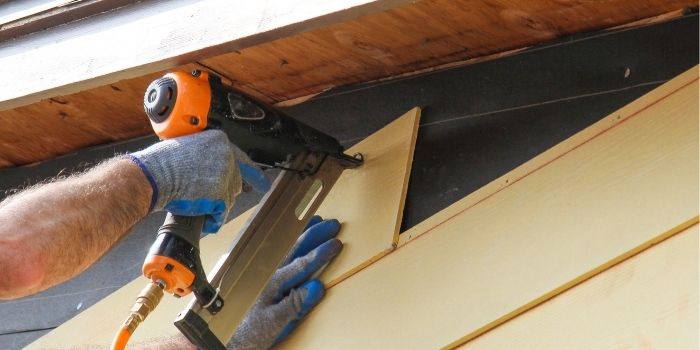
Suppose you need to hang a wooden cabinet on your garage wall; you may wonder how you should go about securing wood to concrete without having to drill into it.
If you need to screw something into a concrete wall or floor, this can be difficult as you must ensure that the screws have enough grip to stay put. But that doesn’t mean you cannot.
Below, I will explain the different methods to use to secure wood to concrete and cinder blocks both indoors and outdoors with and without the need for a drill.
First, let’s start with fastening wood to concrete using screws.
Screwing Wood into Concrete
Wood can be connected to interior concrete walls or floors using anchor bolts, standard screws, nails, or screws with anchors.
There are different types of screw-down fasteners you can use, and each of them requires a predrilled hole.
Some of them need anchors inserted into the concrete, while others simply grip the edges of the hole.
Anchor bolts are usually put into the holes that have already been drilled into the concrete or in the concrete as it sets. The holes will then need to be aligned and drilled into the wood before you can use nuts and washers to secure them.
Alternatively, you can nail wood to concrete using powder-actuated fasteners. It’s an easy process, though it can be a bit noisy.
- Load the right cartridge and nail for the PAT and concrete.
- Grip the PAT firmly and anchor it perpendicular to the concrete surface and wood.
- Press the nose tightly against the wood.
- Activate the trigger and strike the top with a hard blow from a hammer.
- Be sure the spent casting gets ejected.
Remember, powder-actuated fasteners are permanent; they can’t be removed easily and will usually damage the concrete and the wood when extracting them.
Furthermore, they need as much as 1,000 pounds of force to remove properly.
So, it’s a good idea to always talk to your local building department to make sure these types of fasteners are allowed to be used where you live.
Gluing Wood to Concrete Walls or Floors
There are instances where screws and nails are not recommended or even permitted for use when fastening concrete and wood plates.
Some insurance companies and local building departments prohibit using them if there are any radiant heat tubes or lines that are stuck in the concrete.
In these cases, you can glue wood to the concrete wall instead of using nails, bolts, or screws.
Below are a few products you can consider as an alternative to screws or nails to provide more bonding strength.
1- Gorilla Glue
This is not simply a general-purpose glue. It also works as a high-bonding caulk.
Glues like Gorilla Heavy Duty Construction Adhesive can bond wood to concrete for both outdoor and indoor applications, including underwater.
Much like with any other kind of glue, the surface needs to be clean. You’ll get better results on kiln-dried or dry wood as opposed to treated wood.
2- Liquid Nails
This is a special construction adhesive that has various products under the brand name Liquid Nails. Some anchor wood to concrete, but others won’t.
Some are only rated for use indoors, so make sure you choose the appropriate one. Choose polyurethane Liquid Nails adhesive for wood to concrete applications.
Be sure you follow the directions and make sure the temperature is between 40 and 90 degrees Fahrenheit.
The finished result is considered permanent since it can damage both the concrete and wood if you attempt to break the bond.
3- Epoxy Glue
Most wood-to-concrete epoxies have two-part mixtures that use applicators like dual syringes that mix a hardener with resin to be then applied in stripes, strips, or zigzags.
Most epoxies aren’t flexible, so natural contraction and expansion of the bonded materials can cause damage.
There are various construction epoxies and adhesives you can use to adhere wood to concrete.
The biggest concerns with adhesives are moisture, curing time, drying time, cost, and permanency.
Other things that need to be considered include humidity, ambient temperature, horizontal or vertical application, above or below grade, and the size of the job.

Tips for Using Adhesives for Connecting Wood and Concrete
Many construction adhesives are applied using a caulking gun and will need around 10 minutes to dry on the surface and seven days to cure fully.
Epoxies come with their applicator and are usually set more quickly, with a cure time between 4 and 72 hours.
Both of these are usually applied in a zigzag pattern, though some manufacturers have specific application requirements that you should look out for before proceeding.
After the adhesive has been cured, the bond is typically permanent since trying to remove it can damage the wood and even the concrete surface.
This will also help seal the gaps between the concrete or plate to ensure better air tightness.
Keep in mind that moisture can make a wood contract and expand, which can cause the bond to break.
Furthermore, some adhesives are not recommended for basement or below-grade use since the dampness can affect their ability to bond.
Wood that is pressure- or moisture-treated might be better, but some glues don’t bond well with treated wood. Be sure you choose a product that fits your requirements.
Fastening furring strips or 2×4 to concrete floors and walls uses a similar method. Below, you can get familiar with the tips and processes.
- Remove grease, dust, debris, and loose material from the concrete surface, and be sure you work in temperatures between 65 and 95 degrees Fahrenheit for the best results.
- Use a pencil or chalk line on the concrete to figure out where the wood needs to go, as you don’t want to slather glue all across the concrete for nothing.
- Apply the adhesive to the wood evenly, usually in a zigzag line.
- Lift, tip, or move the wall into place or press on the furring to ensure they line up with the line on the concrete.
- Use wedges, weights, or bracings to compress and hold the furring strip or plate on the bottom in a position that sits firmly against the concrete.
Once done, clean up any adhesive that has spilled using a damp cloth or the solvents.
Also, be sure you allow it to dry and cure for as long as 24 hours. In projects like these, it is generally thought that the longer you let it cure, the better.
Final Thoughts
Anchoring wood to concrete without a drill can be accomplished using various methods, including a hammer and cut or concrete nails or construction adhesives. You could also use a powder-actuated tool.
The methods work indoors and outdoors on untreated and treated wood alike, but be sure to read the manufacturer’s instructions on the tools and products you use for best results.
Share the post "Securing Wood to Concrete Wall (With & Without Drilling)"

Hi, I am Mark Garner a professional carpenter, woodworker, and DIY painter. I live in the small city of Peoria, Arizona as a semi-retired woodworker. I have started this blog with a simple motive to help you with my wood experience in this sector. If you like to know more about what I love doing and how it all got started, you can check more about me here.





